I've used HP branded disks in SGIs before. An O2 is not *that* picky...
It's possible that something else is going on, better check before you spend money for nothing.
* I believe the U320 spec makes 'narrow' SCSI support optional, but I've never seen an LVD disk that had issues negotiating SE mode. The O2 is ultra-wide (SE, 40MB/s).
* Maybe the disk doesn't insert securely into the backplane -- you could try to clean things or try with an external disk.
* Maybe these disks are from sort of array and have a non-standard sector size (other than 512bytes/sector)?. This usually affects FC disks, though. With 'fx' you can verify this, 'options' > 'show' > 'geometry', look for data bytes/sec.
* Maybe you should boot the O2 into 'fx' and run a disk wipe: 'exercise' > 'sequential' > 'write-only' > from 0 to whole disk range. See if that works. You have to re-create a disklabel before you can start the IRIX installation.
It's possible that something else is going on, better check before you spend money for nothing.
* I believe the U320 spec makes 'narrow' SCSI support optional, but I've never seen an LVD disk that had issues negotiating SE mode. The O2 is ultra-wide (SE, 40MB/s).
* Maybe the disk doesn't insert securely into the backplane -- you could try to clean things or try with an external disk.
* Maybe these disks are from sort of array and have a non-standard sector size (other than 512bytes/sector)?. This usually affects FC disks, though. With 'fx' you can verify this, 'options' > 'show' > 'geometry', look for data bytes/sec.
* Maybe you should boot the O2 into 'fx' and run a disk wipe: 'exercise' > 'sequential' > 'write-only' > from 0 to whole disk range. See if that works. You have to re-create a disklabel before you can start the IRIX installation.
_________________
Now this is a deep dark secret, so everybody keep it quiet

It turns out that when reset, the WD33C93 defaults to a SCSI ID of 0, and it was simpler to leave it that way... -- Dave Olson, in comp.sys.sgi
Currently in commercial service:

 (2x)
(2x)

In the museum : almost every MIPS/IRIX system.
Wanted : GM1 board for Professional Series GT graphics (030-0076-003, 030-0076-004)













 Took me a while to find one with 32 (licensed!) ports for an acceptable price, and on the right continent. As a bonus, it also come with Extended Fabric, Fabric Watch, Performance Monitor and Trunking licenses. That should keep me busy for a while
Took me a while to find one with 32 (licensed!) ports for an acceptable price, and on the right continent. As a bonus, it also come with Extended Fabric, Fabric Watch, Performance Monitor and Trunking licenses. That should keep me busy for a while




















